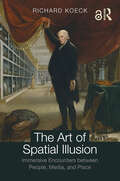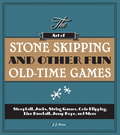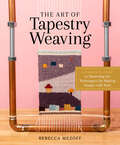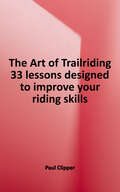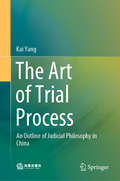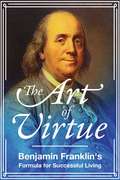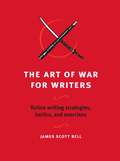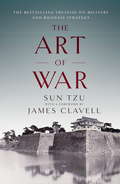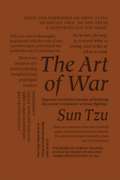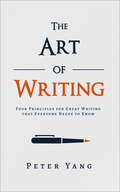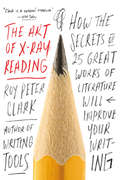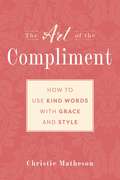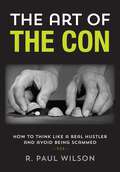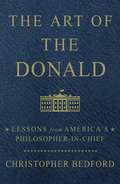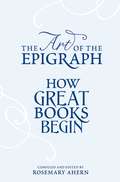- Table View
- List View
The Art of Southern Charm
by Deborah Davis Patricia AltschulThe surprise breakout star of Bravo&’s hit reality show, Southern Charm, introduces an essential lifestyle guide as refreshing and fun as a gin martini. &“Patricia on #SouthernCharm, like lookin&’ in the damn mirror. Cheers queen.&”—Lady Gaga Fan-favorite Bravolebrity Patricia Altschul from the primetime show Southern Charm finally brings fans her eagerly anticipated opus on etiquette and living a glamorous Southern lifestyle. Patricia provides advice on every situation, from hosting a memorable cocktail party, to decoding the dress code for any event, to handling a drunken boor at the dinner table, to delivering the perfectly phrased insult—like her now iconic &“shameless strumpet.&” The Art of Southern Charm takes readers inside the world of Charleston&’s most captivating grande dame, who (with Michael the Butler) offers a blueblood&’s blueprint for curating and celebrating life at its best. &“Some viewers might watch the Bravo reality show Southern Charm to witness the escapades of Charleston&’s young elite, but at T&C we watch just to see Patricia Altschul in action . . . She&’s the show&’s resident expert in decorum, manners, and entertaining.&”—Emily Selter, Town & Country &“Since Southern Charm premiered in 2014, Mrs. Altschul, 78, has emerged as a tart-tongued matriarch doing the work of a Greek chorus for a cast in which half the members can barely figure out how to get out of bed before noon (and once there, how to proceed without a beer) . . . Some of Mrs. Altschul&’s points of view may seem out of touch . . . But her commentary can also be incisive and funny, sparking roundups of her zingers across the internet.&”—The New York Times
The Art of Spatial Illusion: Immersive Encounters between People, Media, and Place
by Richard KoeckContemporary art, entertainment, and architecture cultures offer a growing amount of digitally mediated spatial experiences, situated either in the metaverse (e.g. VR) or location-based in physical realms (e.g. AR), increasingly powered by generative systems (e.g. AI). Are such spatially “immersive experiences” a new phenomenon and dependent on digital innovation?The Art of Spatial Illusion: Immersive Encounters between People, Media, and Place is an insightful exploration of the evolving relationship between humans, media, and spatial environments, tracing their progression from the Renaissance, via Modernity and Postmodernity, to today’s digital age. The author offers a compelling reading and re-evaluation of architectural history and media theory, drawing connections between historical practices, technological innovations, and contemporary immersive experiences.Inspired by scholars such as Walter Benjamin and Jean Baudrillard, the book discusses how technological advancements have transformed our situatedness in “image-spaces”, highlighting the shift from material authenticity to digital reproductions. The book is structured into four parts – The Surface, The Stage, The Interface, and The Hybrid – each exploring different aspects of spatial illusions and their implications. It offers a critical perspective on the creation of architectural, immersive environments, examining the motivations behind them and their broader cultural and political contexts.Richly illustrated and deeply researched, The Art of Spatial Illusion is an essential reading for anyone interested in architecture and art as well as media archaeology, history, and theory. Seeing new, thought-provoking architectural propositions emerging on our horizon, the author provides a comprehensive understanding of how immersive experiences shape our perception of reality.Chapter 3 of this book is freely available as a downloadable Open Access PDF at http://www.taylorfrancis.com under a Creative Commons (CC-BY) 4.0 license.
The Art of Sportscasting: How to Build a Successful Career
by Tom HedrickAuthor Tom Hedrick has elicited and gathered strategic and tactical advice from the top professionals in sporstcasting. Over 76 top-notch sports broadcasting personalities share their experience and acquired wisdom, including Curt Gowdy, Ray Scott, Bob Costas, Jack Buck, Jim Nantz, Keith Jackson, Bob Starr, Joe Castiglione, Kevin Harlan, and Mitch Holthus. While their stories are enjoyable and motivating, these pros do more than reminisce. They itemize specific actions with lists of do's and don'ts and tips. Most importantly, they talk about the strong personal values and philosophies that are and have been essential to their success and to the journey for getting there.
The Art of Stone Skipping and Other Fun Old-Time Games
by J. J. FerrarIt's an old-time playtime--nothing electronic, just games that have stood the test of time! They help children build skills like hand-eye coordination, problem solving, and simply learning how to be a good team player and work well with others. But most of all, they're lots of fun. This collection of timeless games guarantees kids a great time--by themselves, with a group of friends, or with their family. And best of all, no batteries are required . . . and very little equipment, too.There's Hopscotch and Dodgeball, Four Square and Stoopball, Horse and One Old Cat (a ball game similar to baseball, but with only one base). All you need is your brain--and occasionally a paper and pen--to play games like Association, the Minister's Cat, and Dumb Crambo (which is similar to Charades, but has a rhyming twist). A rainy day with no pals around would be just right to make Hand Shadows, walk on Can Stilts, or practice Jacks. Don't forget card games like Crazy Eights and Rummy, Crab and Sack Races, and old favorites like Duck, Duck, Goose and Red Rover. And because no parent likes to hear the whine of "Are we there yet?" there's a whole chapter of games for the car!Black-and-white illustrations keep the old-timey feel while getting kids excited to play. Simple instructions explain how many people can play, what you need, the object of the game, and the basic rules. For extra entertainment, there are also lots of fun facts about the history of the games sprinkled throughout. This book is so packed with activities that kids will want to turn off their computers, shut down their PlayStations and Xboxes, and get playing the old-fashioned way!
The Art of String Teaching
by Michael HopkinsThe Art of String Teaching a hybrid of written text and high-quality online videos is a comprehensive string pedagogy resource covering everything from the origins and history of the string family to advanced-level string techniques. This one-of-a-kind resource has been divided into two parts. In Part I, Michael Hopkins offers an orientation to string education, outlines his philosophical approach to string education, and provides four chapters on the foundational aspects of string playing for beginning string players. Part 2 focuses on intermediate- and advanced-level instruction, touching on such topics as left-hand shifting, vibrato, bowing techniques, tuning skills, improvisation and composition, and music listening, among others. The two concluding chapters offer insight into the string rehearsal and how to run a successful orchestra program. The appendices contain an abundance of practical and convenient teacher resources, including worksheets, flashcards, string repertoire, scales and arpeggios, a template for method book analysis, and sample assessments and rubrics. QR codes throughout the book link to online video demonstrations of string techniques, and the spiral binding is ideal for playing the included string repertoire from a music stand. This book serves as a useful reference guide for professional orchestra conductors, teachers of group string classes, and private studio teachers. It also addresses the needs of students whose primary instrument is not strings and is suited for use in a string techniques or pedagogy course at the college level.
The Art of Tapestry Weaving: A Complete Guide to Mastering the Techniques for Making Images with Yarn
by Rebecca MezoffPut aside those preconceptions of dusty, medieval tapestries hanging on castle walls! Tapestry weaving has a whole new look, and fiber enthusiasts of all levels are eager to try their hand at creating images with yarn. Rebecca Mezoff, a renowned teacher of contemporary tapestry weaving, shares her techniques in this in-depth guide to every aspect of the process, from developing a color palette to selecting yarn, warping the loom, and weaving the image. Crafters can choose from inexpensive tabletop and hand-held looms to larger floor looms. Detailed step-by-step photos and inspiring examples from a range of weaver-artists make this a one-stop resource for tapestry weaving how-to. This publication conforms to the EPUB Accessibility specification at WCAG 2.0 Level AA.
The Art of Teaching Writing, New Edition
by Lucy McCormick CalkinsWhen Lucy Calkins wrote the first edition of The Art of Teaching Writing, the writing workshop was a fledgling idea, piloted by a few brave innovators. Now, as she brings us this new edition, the writing workshop is at the foundation of language arts education throughout the English-speaking world. This new edition, then, could easily have been a restatement, in grander, more confident tones, of the original classic. Instead, it is an almost entirely new book. <P><P>Clearly, during the time in which Calkins's original ideas have spread like wildfire, her focus has not been on articulating and defending those ideas, but on developing and rethinking them. Respecting and responding to the questions which have arisen as thousands of teachers establish writing workshops in their classrooms, and drawing upon the latest knowledge in the field and her own intimate understanding of classroom life, Calkins has re-thought every line and every facet of her original text. <P><P>In this new edition, Lucy has major new chapters on assessment, thematic studies, writing throughout the day, reading/writing relationships, publication, curriculum development, nonfiction writing and home/school connections. More than this, she has deepened her understanding of the writing process itself: <P><P>"When I wrote the first edition, I saw writing as a process of choosing a topic, turning the topic into the best possible draft, sharing the draft with friends, then revising it. But I've come to think that it's very important that writing is a process not only of recording, but also of developing a story or an idea. Now, in this new edition, I describe writing episodes that do not begin with a topic and a draft but instead with something noticed or something wondered about. When writing begins with something that has not yet found its significance, it is more apt to become a process of growing meaning."
The Art of Thank You
by Connie LeasPart inspirational, part how-to, The Art of Thank You shows how to write well-crafted notes of gratitude for all occasions. Readers learn when, and when not, to send a card, whether an e-mail is ever appropriate, and how to get children to write thank-you notes. Learn the secrets of the whys whens, and how-tos of thank-you-note writing. The Art of Thank You will motivate you or perhaps someone you know who could use a little encouragement to pick up a pen and take the time to express gratitude. Interspersing straightforward guidelines with funny, inspiring anecdotes and examples by such luminaries as Abraham Lincoln and Ernest Hemingway, the author's practical tips make this handy little book an indispensable resource.
The Art of Thank You: Crafting Notes of Gratitude
by Connie LeasLearn the secrets of the "whys," "whens," and "how-tos" of thank-you note writing. The Art of Thank You will motivate you--or perhaps someone you know who could use a little encouragement--to pick up a pen and take the time to express gratitude. Interspersing straightforward guidelines with funny, inspiring anecdotes and examples by such luminaries as Abraham Lincoln and Ernest Hemingway, the author's practical tips for newlyweds, business people, and children make this handy little book an indispensable resource.
The Art of Trailriding: 33 Lessons Designed to Improve Your Riding Skills
by Paul ClipperYou can ride a dirt bike, but do you really feel comfortable on it, and confident that you know how to handle it in any situation? In The Art of Trailriding, author Paul Clipper, former staffer at Dirt Bike magazine and past owner of Trail Rider magazine, digs into his 40 years of off-road riding experience to explain in simple terms how your bike works and what you have to do to gain control. Clipper all about proper set-up, and then goes on to carefully details what to do and what to expect in specific riding circumstances.
The Art of Trial Process: An Outline of Judicial Philosophy in China
by Kai YangThis book focuses on the reality of China’s modern judiciary, systematically demonstrating and discussing the judicial philosophy and judicial ethics as applied by Chinese courts and judges. In order to illustrate the methods of jurisprudence and sociology of law in the context of China’s judicial practice and practicability of applicable laws, it also addresses judicial methodology and Chinese judges' trial methods. Based on comparative study and aiming at global judicial reform, the book provides valuable guidance and insights for readers pursuing a detailed understanding of modern Chinese judiciary, Chinese judges and Chinese rule of law. The book is intended to primarily serve the need of legal professionals around the world, in particular those who are interested in China’s judicial system.
The Art of Virtue: Ben Franklin's Formula for Successful Living
by Benjamin FranklinAn indispensable guide to right living from a Founding Father. Benjamin Franklin, one of our nation’s most revered founders, was a man of uncommonly fine common sense. Although he was never able to finish his project of compiling a comprehensive compendium of practical wisdom, he was able to lay down the beginnings of this work in his later writings. Collected within this volume are Franklin's writings organized around his timeless philosophy on living well, containing his thoughts on justice, moderation, chastity, and more. The Art of Virtue is a simple, concise, and illuminating guide to living a virtuous and fulfilling life. Perfect for readers young and old alike.
The Art of War & Other Classics of Eastern Philosophy (Leather-bound Classics)
by Sun Tzu Confucius Lao-Tzu MenciusThe words of the ancient Chinese sages are as timeless as they are wise.The words of ancient Chinese philosophers have influenced other thinkers across the world for more than 2,000 years, and continue to shape our ideas today. The Art of War & Other Classics of Eastern Philosophy includes translations of Sun Tzu's Art of War, Lao-Tzu's Tao Te Ching, the teachings of the master sage Confucius, and the writings of Mencius. From insights on warfare and diplomacy to advice on how to deal with one's neighbors and colleagues, this collection of classical Eastern philosophy will provide readers with countless nuggets of wisdom. IBPA Benjamin Franklin Gold Award Winner 2017!
The Art of War for Writers: Fiction Writing Strategies, Tactics, and Exercises
by James Scott BellStrategies and Tactics for the Master NovelistSuccessfully starting and finishing a publishable novel is often like fighting a series of battles. You not only have to work hard to shape memorable characters, develop gripping plots, and craft dazzling dialogue, but you also have to fight against self-doubts and fears. And then there's the challenge of learning to navigate the ever-changing publishing industry.That's why best-selling novelist James Scott Bell, author of the Write Great Fiction staples Plot & Structure and Revision & Self-Editing, came up with the ultimate novel-writing battle plan: The Art of War for Writers.You'll find tactics and strategies for idea generation and development, character building, plotting, drafting, querying and submitting, dealing with rejection, coping with unrealistic expectations, and much more.With timeless, innovative, and concise writing reflections and techniques, The Art of War for Writers is your roadmap to victory.
The Art of War for Writers: Fiction Writing Strategies, Tactics, and Exercises
by James Scott BellStrategies and Tactics for the Master NovelistSuccessfully starting and finishing a publishable novel is often like fighting a series of battles. You not only have to work hard to shape memorable characters, develop gripping plots, and craft dazzling dialogue, but you also have to fight against self-doubts and fears. And then there's the challenge of learning to navigate the ever-changing publishing industry.That's why best-selling novelist James Scott Bell, author of the Write Great Fiction staples Plot & Structure and Revision & Self-Editing, came up with the ultimate novel-writing battle plan: The Art of War for Writers.You'll find tactics and strategies for idea generation and development, character building, plotting, drafting, querying and submitting, dealing with rejection, coping with unrealistic expectations, and much more.With timeless, innovative, and concise writing reflections and techniques, The Art of War for Writers is your roadmap to victory.
The Art of War: The Bestselling Treatise on Military & Business Strategy, with a Foreword by James Clavell
by James Clavell Sun TzuSun Tzu was one of the greatest army generals who ever lived. He wrote The Art of War in the fifth century BC and yet his words are still resoundingly relevant to our modern lives. His writings on aspects of warfare from the laying of plans to the tactics and psychology of manoeuvering an army, to the proper use of spies, resonate for us in today's world of cut-throat, ruthless business. With James Clavell's insightful foreword and notes, this classic is widely seen as a necessity on the bookshelf of military leaders and boardroom executives alike.
The Art of War: The Essential Translation Of The Classic Book Of Life (Wordsworth Classics #909)
by Sun TzuDated to about fifth century BC, The Art of War is considered the oldest treatise on war in the world. Attributed to Sun Tzu of the Zhou dynasty, the book is composed of thirteen chapters, each addressing a particular aspect of warfare, such as planning offenses, military combat, and the employment of spies. Influential in eastern civilization for millennia and in western culture since its first translation in the 18th century, the teachings of this book have been applied to scenarios as varied as office politics, the Vietnam War, and American football. Now this living military heirloom is available as part of the Word Cloud Classics series in a chic affordable edition for readers everywhere.
The Art of Writing: Four Principles for Great Writing that Everyone Needs to Know
by Peter YangRediscover the lost art of excellent writing—a valuable skill through the ages, and even more so in the twenty-first century.Since the invention of writing, the written word has fueled humanity’s astonishing progress. Thus, the ability to write effectively and beautifully has long been revered and rewarded.And yet in the digital age, people have begun to believe that this talent is somehow obsolete: that writing is something unworthy of study beyond the basic mechanics of vocabulary and syntax and grammar, that mediocre prose is acceptable in a world crying out for clear and precise communication.Peter Yang believes otherwise.The Art of Writing is Yang’s highly practical treatise on the four key principles of dazzling, effective writing—economy, transparency, variety, and harmony. Far from your garden-variety style guide, this book offers principles that apply to everyone, whether you’re writing an inauguration speech, a novel, or a letter home to Mom.Great writing is a skill, and this book gives you the tools to make your words shimmer on the page (or the screen). Packed with real-world insights and advice, The Art of Writing is your ultimate guide to transforming your writing and unleashing your inner artist.
The Art of X-Ray Reading: How the Secrets of 25 Great Works of Literature Will Improve Your Writing
by Roy Peter ClarkRoy Peter Clark, one of America's most influential writing teachers, offers writing lessons we can draw from 25 great texts.Where do writers learn their best moves? They use a technique that Roy Peter Clark calls X-ray reading, a form of reading that lets you penetrate beyond the surface of a text to see how meaning is actually being made. In THE ART OF X-RAY READING, Clark invites you to don your X-ray reading glasses and join him on a guided tour through some of the most exquisite and masterful literary works of all time, from The Great Gatsby to Lolita to The Bluest Eye, and many more. Along the way, he shows you how to mine these masterpieces for invaluable writing strategies that you can add to your arsenal and apply in your own writing. Once you've experienced X-ray reading, your writing will never be the same again.
The Art of iPhone Photography
by Nicki Fitz-Gerald Bob WeilThe Art of iPhone Photography explores how 45 of today's best iPhonegraphers from around the world conceived, composed, and created some of their finest and best-known pieces-all in their own words. Through an understanding of the artists' visions, creative decisions, and techniques, beginning through advanced iPhoneographers will immediately be able to apply what they learn and take their own photographic art to the next level.Key features of the book include: A wide variety of styles and subjects: Landscapes, street photography, abstracts, architecture, portraits, collages, concept pieces, etc. Detailed tutorials: Example artworks from authors and contributing photographers accompanied by descriptions of how each piece was created from both a creative and technical standpoint Explanations for practical use of nearly 100 apps, including BlurFX, Camera+, Iris Photo Suite (now Laminar), Juxtaposer, Photogene2, Pixlr-o-matic, ScratchCam FX, Snapseed, Superimpose, and TouchRetouch iPhoneography gallery: A stunning showcase of works by notable iPhoneographersAlways on, always at hand, and inconspicuously deployed, today's smartphones empower us to record the world in ever newer and more personal ways. By leveraging the photo-editing applications found on the iPhone, professional and amateur photographers alike are able to create not only editorial imagery, but also creative art. "Nicki Fitz-Gerald and Bob Weil, at iPhoneographyCentral.com, have built a community dedicated to the burgeoning collaboration between art and technology that is iPhoneography. Their site, and now this book, offer extensive, in-depth tutorials both for budding iPhoneographers looking to advance their craft, and professionals attempting to harness a new toolkit in service of their vision. What they bring to the table is their belief that 'revealing the man behind the curtain' does not diminish the teacher. Technique does not the artist make, but it does enable the newcomer to find his or her own voice. With thousands of apps available and more flooding the market daily, every new iPhoneographer wonders, What apps should I use? The answer to that question is so complex, with so many variables, that an illustrated tutorial such as this becomes an invaluable tool. There is really nothing like it. It does not offer the advice of a single artist or showcase images from a small artistic segment. Indeed, it offers up stories, knowledge, tips, and secrets from many of the key players in the formation of this movement, showcasing more than 40 artists and tutorials and 80 pages of iPhonic art." - Daria Polichetti, Co-Founder of Los Angeles Mobile Arts Festival
The Art of the Compliment: Using Kind Words with Grace and Style
by Christie MathesonA few well-chosen words can elicit smiles, inspire happiness, transform moods, and turn a bad day into a good one. Philosopher William James once said, "The deepest principle in human nature is the desire to be appreciated." This is a fun, fabulous, reader-friendly book all about compliments-the history of compliments, how to use them, best-loved compliments, and how to take them.
The Art of the Con: How to Think Like a Real Hustler and Avoid Being Scammed
by R. Paul WilsonA sucker is still born every minute. In this modern and interconnected world, con-men are lurking everywhere – it&’s never been easier for them to dupe us, take from us, and infiltrate our lives. One of the world&’s leading and celebrated experts on con-games takes the reader through the history of cons, how they&’ve been updated to the modern age, how they work, how to spot them, and how to protect yourself from being the victim of one.R. Paul Wilson is a con-man who works for the other side – our side. He has spent a lifetime learning, performing, studying, and teaching about the ins and outs of the con world in order to open up our eyes to the dangers lurking about us – and to show us how not to get taken. Paul has never made a living as a con-man, profiting off of marks – he has used his expertise throughout his life to help people avoid cons.In this fascinating book, Paul takes the reader through the history and developments of the con game, what elements from the past are based on basic human psychology and have stood the test of time, what has been updated for the modern era and how it&’s getting used in the computer age, the structure of how these cons work, and – most importantly - how to recognize one, protect yourself and your loved ones, and avoid becoming just another sucker.
The Art of the Donald: Lessons from America's Philosopher-in-Chief
by Christopher BedfordMotivational self-help advice from President Donald Trump, covering everything from leadership and self-confidence to how to succeed in business.President Donald Trump knows about living the good life and achieving success. With his election to the presidency, he added to a life that already includes billions of dollars, worldwide celebrity, and a beautiful family, despite legions of haters. In The Art of the Donald, Daily Caller News Foundation editor-in-chief Christopher Bedford takes you inside the new president’s unorthodox mind, unlocking the genius of his approach to everything in life and offering you insight into navigating life the Trump way. Featuring personal campaign-trail anecdotes and lessons from Trump’s long career as a businessman and politician, The Art of the Donald offers you life-changing pieces of advice, including Keeping your message simple and delivering it effectively; Using competition to govern yourself and chaos to confuse your opponents; Cutting out the middlemen and getting directly to the deal-makers; Redefining conflicts and transactions on your own terms; Solving problems with ingenuity instead of money; and Believing in yourself, no matter what your opponents try to say. Written in the style of Sun Tzu’s The Art of War and The Tao of Warren Buffett, this is a must-read for every Trump fan (and even the haters).
The Art of the Epigraph
by Rosemary AhernFor many book Lovers, there is no more pleasing start to a book than a well-chosen epigraph. These intriguing quotations, sayings, and snippets of songs and poems do more than set the tone for the experience ahead: the epigraph informs us about the author's sensibility. Are we in the hands of a literalist or a wit? A cynic or a romantic? A writer of great ambition or a miniaturist? The epigraph hints at hidden stories and frequently comes with one of its own. The Art of the Epigraph collects more than 250 examples from across five hundred years of literature and offers insights into their meaning and purpose, including what induces so many writers to cede the very first words a reader will encounter in their book to another writer. With memorable quotations ranging from Dr. Johnson to Dr. Seuss, Herodotus to Hemingway, Jane Austen to Karl Marx, and A. A. Milne to Marcel Proust, here is a book that allows us a glimpse of the great writer as devoted reader. This lively and distinctive literary companion traces not only the art of the epigraph but the history of the book.

